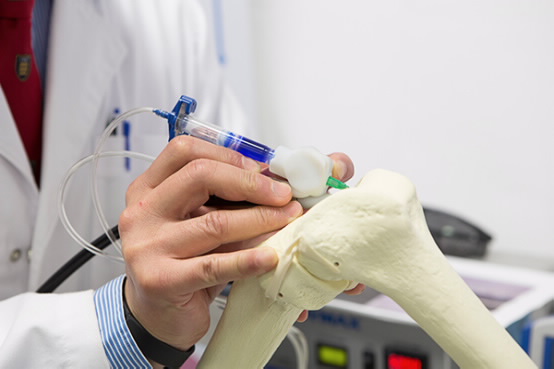BioPen rewrites orthopedic implant surgery
Delivers live stem cells and growth factors at the time of
surgery to regenerate bone, cartilage, muscle, or nerve tissue
December 13, 2013

A
handheld “BioPen” developed in the labs of the University of Wollongong
will allow surgeons to design and deliver customized implants during
surgery (credit: University of Wollongong)
Here’s how it works:
- Similar to a multi-material 3D printer, the BioPen delivers stem cells embedded in a biopolymer carrier (such as alginate, a seaweed extract), protected by a second outer layer of gel material. Growth factors or other drugs can also be included to assist regrowth and recovery.
- As the surgeon “draws” with the BioPen, the two layers of gel are combined in the pen head as they are are extruded onto the bone surface to fill in the damaged bone section.
- An ultraviolet light source (attached to the device) solidifies the materials, providing protection for the embedded cells as they are built up layer-by-layer to construct a 3D scaffold in the wound site.
- Once the cells are “drawn” onto the surgery site, they will multiply, become differentiated into nerve cells, muscle cells, or bone cells, and eventually develop from individual cells into a thriving community of cells in the form of functioning tissue.
The researchers say the BioPen will give surgeons greater control over where the materials are deposited while reducing the time the patient is in surgery by delivering live cells and growth factors directly to the site of injury, accelerating the regeneration of functional bone and cartilage.
The BioPen prototype was this week handed over to clinical partners at St Vincent’s Hospital Melbourne, led by Professor Peter Choong, who will work on optimizing the cell material for use in clinical trials at the proposed Aikenhead Centre for Medical Discovery in Melbourne.
(¯`*• Global Source and/or more resources at http://goo.gl/zvSV7 │ www.Future-Observatory.blogspot.com and on LinkeIn Group's "Becoming Aware of the Futures" at http://goo.gl/8qKBbK │ @SciCzar │ Point of Contact: www.linkedin.com/in/AndresAgostini
 Washington
Washington